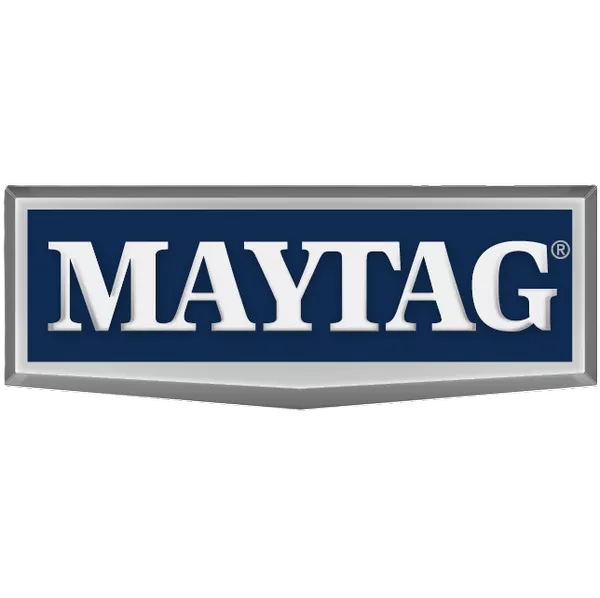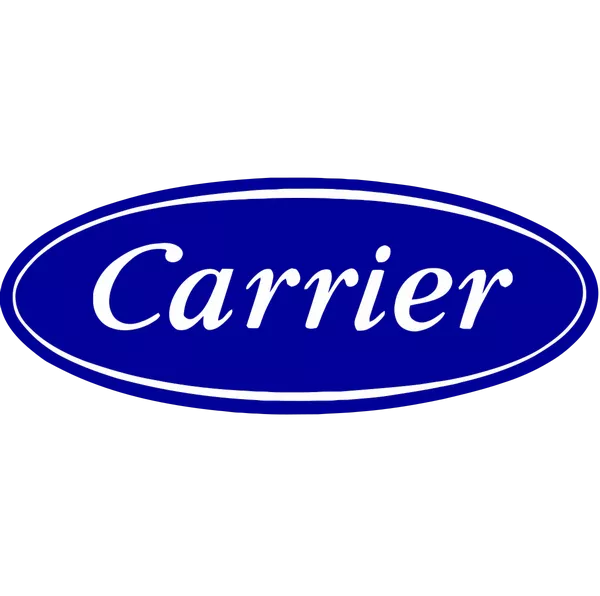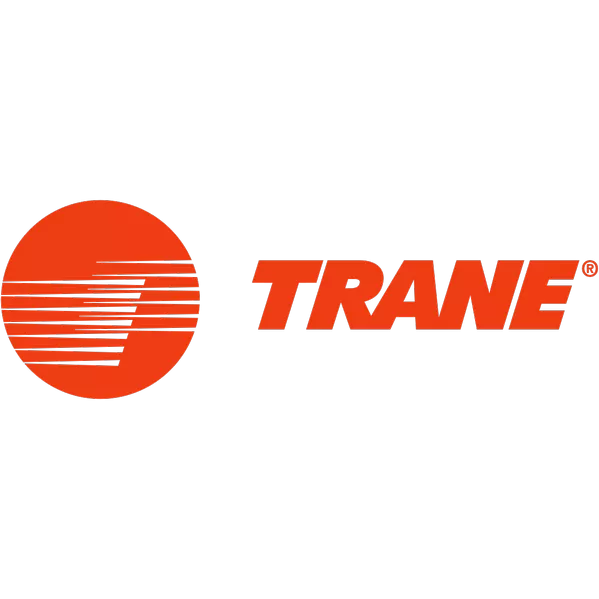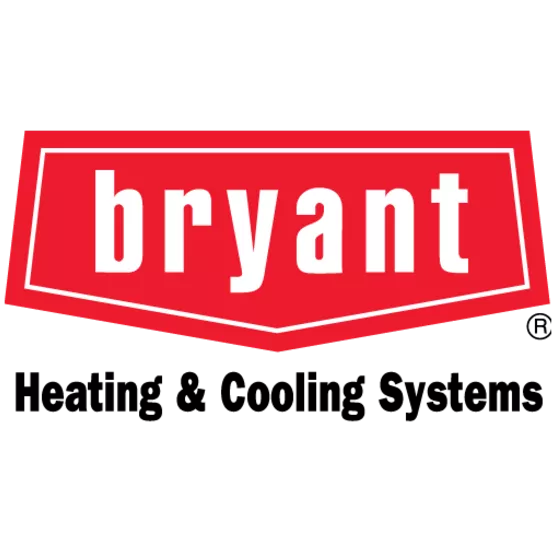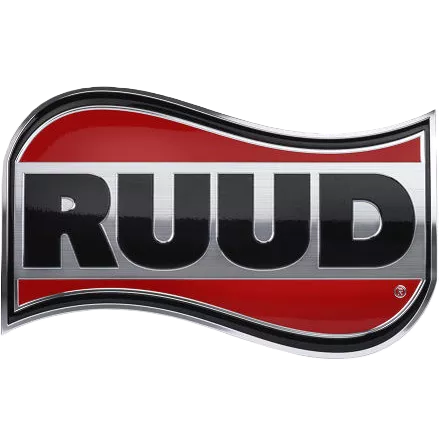Carrier: This flagship stack is best understood as a single system that breathes in sync with the house rather than three boxes that take turns. The chosen trio is the Infinity 26 variable-speed central AC, the Infinity 98 modulating gas furnace, and the Infinity 24 variable-speed heat pump. The focus below is how this communicating set behaves in an ordinary 2 to 4 ton home with imperfect ducts and real-world schedules.
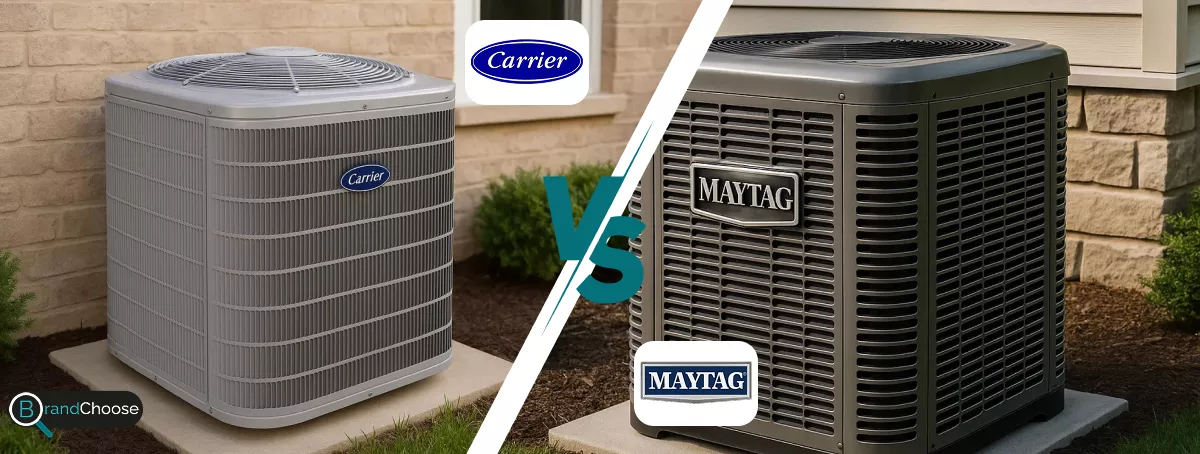
Maytag: This portfolio leans on clear, installer-friendly hardware that favors predictable staging and uncomplicated controls. To mirror our single-brand pick, we evaluate the PSA4BF central AC, the PGC2TE-VS two-stage ECM furnace, and the PSH4BE heat pump as a coordinated trio. The brief here is steady comfort that does not demand a tinkerer at the thermostat and can be serviced with familiar playbooks.
Product Selection
| Primary Use Case | Carrier | Maytag | ||
| Air Conditioner | Infinity 26 | 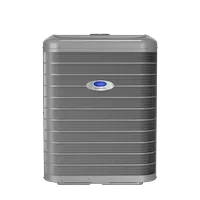 |
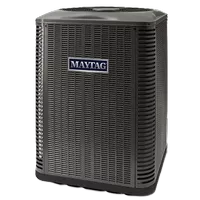 |
PSA4BF |
| Gas Furnace | Infinity 98 | 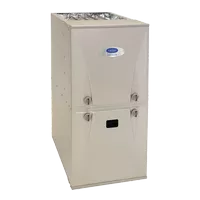 |
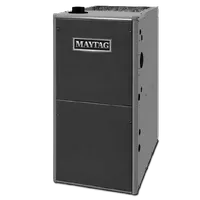 |
PGC2TE-VS |
| Heat Pump | Infinity 24 | 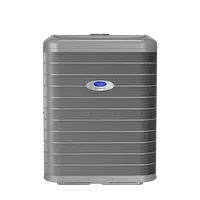 |
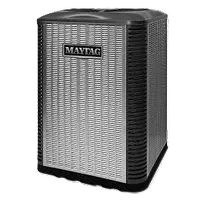 |
PSH4BE |
🟦 Carrier: The ladder is intentionally linear - Infinity at the top, then Performance and Comfort - so stepping up to variable capacity, deeper humidity control, and lower sound feels like moving one rung, not switching ladders. The Infinity 26 + Infinity 98 + Infinity 24 HP combination is a common premium recipe because Carrier publishes matched sets that tie outdoor unit, indoor coil or furnace, and the communicating control together. That preserves staging behavior and advertised ratings across sizes, and it means later upgrades like zoning or advanced IAQ are plug-ins rather than rebuilds.
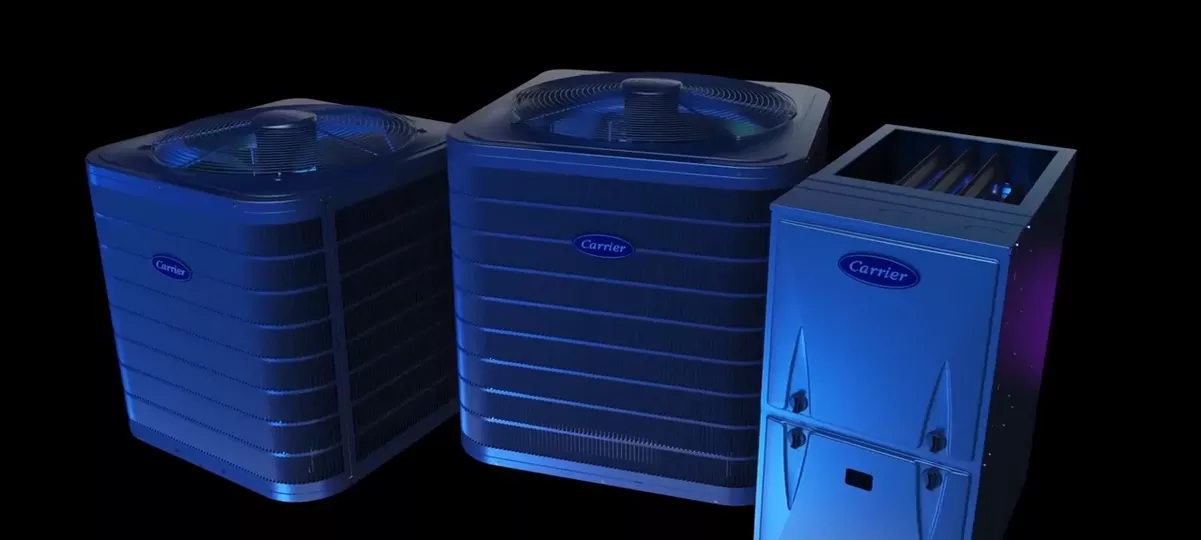
🟪 Maytag: The lineup reads good-better-best with two-stage at the top of most ducted offerings, then single-stage steps for simpler jobs. The PSA4BF + PGC2TE-VS + PSH4BE stack shows up often in 2 to 4 ton replacements where the brief is quiet two-stage cooling or heating with an ECM blower (ECM is an electronically commutated motor that can vary speed precisely) and a control strategy that does not get fussy. Matchup charts keep coil and air-handler choices tidy so the staging you paid for survives a tonnage change.
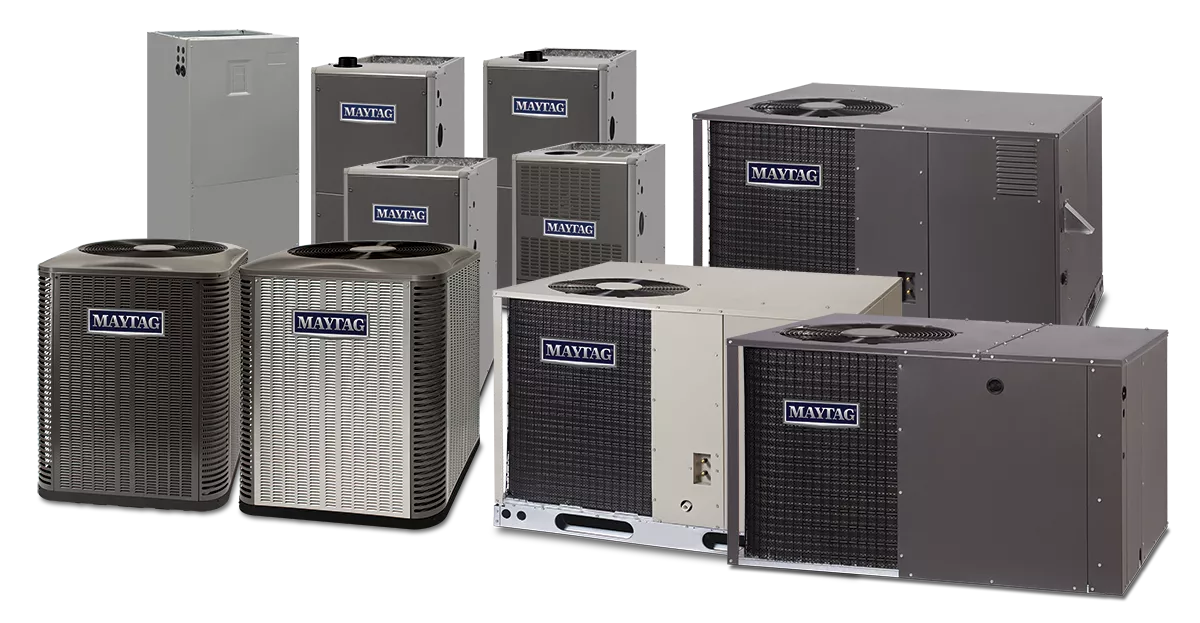
✅ Verdict: Carrier is the easy on-ramp to true variable capacity across AC and HP, while Maytag keeps the catalog simple for buyers who want proven two-stage behavior without wading through near-duplicates.
Customer Support & Warranty
🟦 Carrier: Registration delivers 10-year parts on premium equipment and robust furnace heat-exchanger terms. Dense dealer coverage and a mature communicating platform matter in July - event logs, equipment IDs, and coil data stay with the thermostat, so a tech lands, sees the history, and fixes causes rather than symptoms. Parts pipelines in most metros keep common boards, sensors, and ECM modules in arm’s reach, which shortens peak-season downtime.
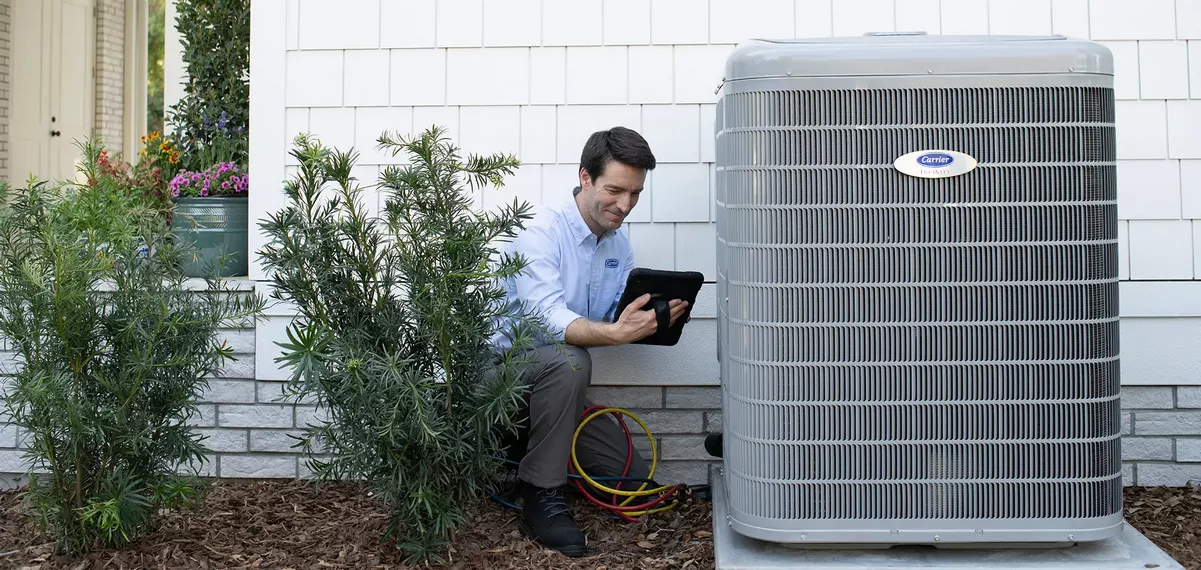
🟪 Maytag: Registration likewise brings 10-year parts at the flagship tier with strong exchanger coverage on furnaces, and distributors under the Nortek umbrella typically stock shared boards and motors across sister brands. Service calls stay predictable if the approved coil pairings and factory staging profiles are kept intact after repairs. In regions with good wholesaler density, turnaround times feel brisk and documentation is clear enough that even mid-season swaps keep features intact.

✅ Verdict: Carrier is the safer bet for coast-to-coast uniformity and deep control logs, while Maytag delivers a solid, no-surprises experience where its distributor network is strong.
Energy Efficiency
🟦 Carrier: The Infinity 26 and Infinity 24 live in the premium SEER2 tier (SEER2 is the current seasonal cooling-efficiency test), the Infinity 98 reaches ultra-high AFUE (AFUE is gas furnace fuel-to-heat efficiency), and savings come from partial-load operation - the inverter compressor and variable-speed blower stretch cycles at low power to cut on-off losses. With sealed ducts and charge verified by superheat and subcool checks (temperature confirmations that refrigerant is boiling and condensing in the right places), you get double-digit drops in seasonal bills without resorting to lower setpoints.
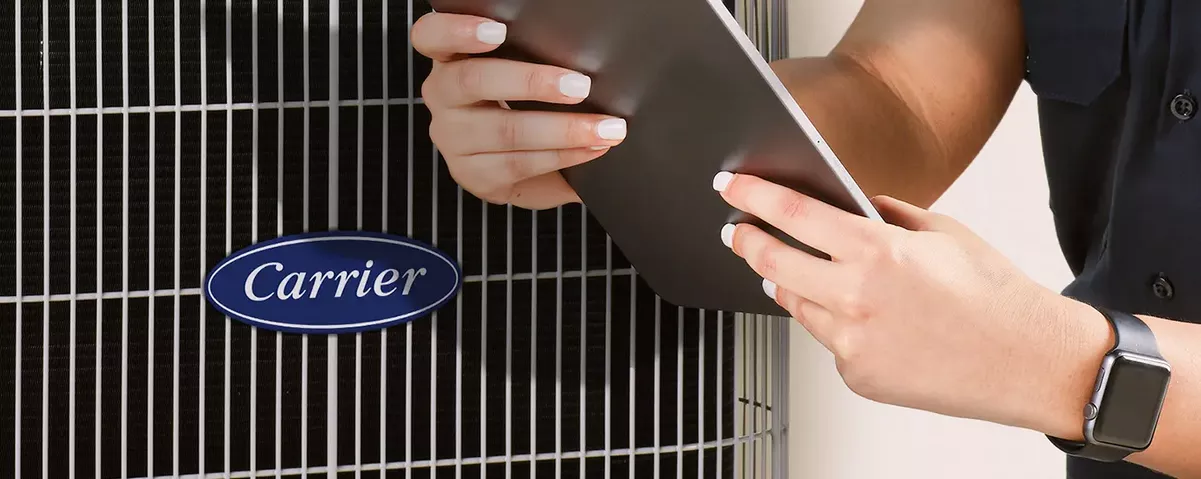
🟪 Maytag: Two-stage AC and HP target upper mid-tier SEER2/HSPF2 results (HSPF2 is seasonal heating efficiency for heat pumps) and the PGC2TE-VS furnace runs high AFUE while the ECM blower ramps gently. Efficiency here is about staying on low stage long enough to avoid short cycling and to keep the coil in a temperature band that removes moisture comfortably. With airflow set near 350–400 cfm per ton (target airflow per ton of cooling) and a weighed-in charge, homeowners see steady comfort and respectable savings, even if the headline numbers are a notch below variable-speed flagships.
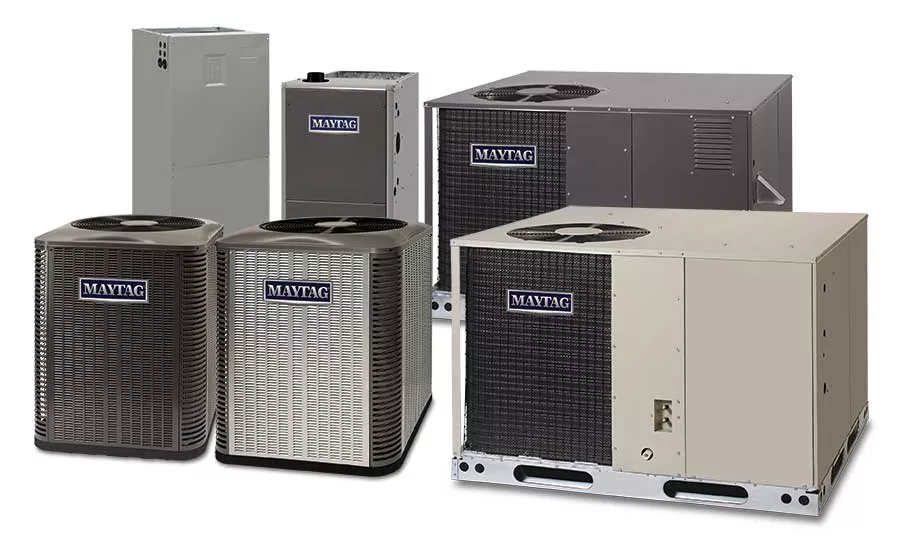
✅ Verdict: Carrier reaches higher published peaks and converts them into real-home savings via deep turndown; Maytag delivers credible reductions with simpler two-stage hardware when airflow and charge are dialed in.
Smart Features & Connectivity
🟦 Carrier: The Infinity System Control is a true communicating thermostat - the control and equipment exchange live data so modulation targets comfort rather than simple on off. It coordinates compressor speed, blower cfm, and coil temperature, handles zoning and dehumidify-on-demand, and keeps event logs that make diagnostics fast and surgical. Staying in-ecosystem preserves features like staged airflow during humidity pulls and dual-fuel balance-point logic.

🟪 Maytag: Controls aim for clarity over flash. Communicating options are available, but most installs pair two-stage equipment with a thermostat that stages predictably and exposes the few numbers that matter to techs. IAQ add-ons integrate in familiar ways, and the day-to-day interface is intentionally plain so households are not tempted to over-tweak settings that already work.

✅ Verdict: Carrier is the one-brain approach that orchestrates the whole house with granular logs, while Maytag keeps the experience deliberately straightforward - fewer knobs to turn, fewer ways to misconfigure.
Noise Level
🟦 Carrier: At everyday loads the inverter and indoor ECM blower (electronically commutated motor that modulates speed precisely) idle at modest rpm, so the outdoor note is a broad hush instead of a tone. Quiet hinges on long, low-power cycles, a level pad, rubber isolation on the line set, and keeping external static pressure reasonable in the ducts (external static pressure is the system’s airflow resistance, measured in inches of water column). With returns sized generously and filter racks sealed, ramps are nearly imperceptible and registers sound like a soft exhale.
🟪 Maytag: Two-stage hardware is inherently calm on first stage, and the PGC2TE-VS blower’s smooth ramps avoid pressure spikes that make trunks chatter. Outdoors, cabinet stiffness and a swept fan help, but the big swing factor is how rarely the condenser is asked to run at high speed. If the pad is flat, the line set is decoupled, and return area is not starved, the system settles into a steady background hush that holds up well in smaller lots.
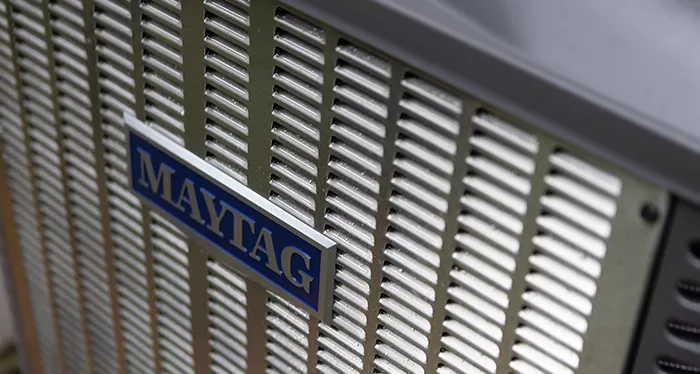
✅ Verdict: Carrier is a touch quieter at the registers when static is challenging; Maytag is pleasantly muted at low stage in typical suburban installs.
Cost & Affordability
🟦 Carrier:
🟪 Maytag:

✅ Verdict:
Reliability & Durability
🟦 Carrier: Powder-coated cabinets and all-aluminum indoor coils help head off formicary corrosion over time (formicary corrosion is microscopic copper pitting caused by household organics). The communicating control logs faults and operating data, which turns intermittent issues into traceable events, and soft starts keep compressor stress down in hot weather. Durable outcomes still rely on fundamentals: charge verified by superheat and subcool readings (temperature checks confirming the refrigerant is boiling and condensing in the right places), airflow near 350–400 cfm per ton (target airflow per ton of cooling), clean coils, and sealed returns.
🟪 Maytag: The platform shares proven components across sister brands under the same umbrella, which helps parts availability at distributors. Aluminum coils keep heat transfer stable when maintained, and the ECM blower reduces mechanical stress by avoiding abrupt speed changes. Long service life follows the same discipline as any ducted system: correct charge, verified airflow, reasonable static, and routine coil cleanings so the equipment is not forced to work harder than it should.
✅ Verdict: Carrier earns a practical nod for deep diagnostic logs and broad parts pipelines; Maytag matches on hardware toughness when commissioning is meticulous.
Cooling Performance
🟦 Carrier: The inverter keeps the evaporator just cold enough to attack both sensible and latent load together (sensible is temperature change, latent is moisture removal). During humidity pulls the control trims cfm per ton so the coil stays colder longer, which boosts moisture pickup without overshooting the setpoint. In practice that yields a stable supply-air delta-T across the coil (delta-T is the return-to-supply temperature drop) and indoor RH that lives in the mid-40s to near-50 percent band on sticky afternoons.
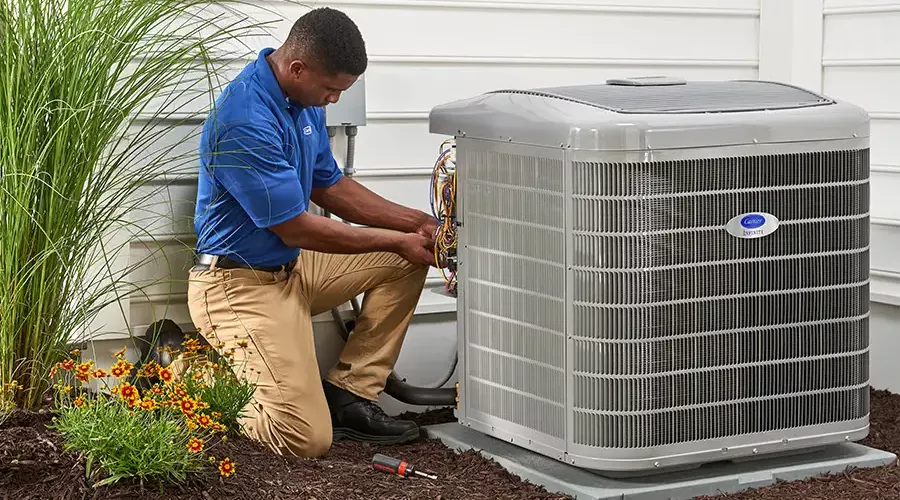
🟪 Maytag: Two-stage operation spends most hours on first stage, which stretches cycles and keeps the coil in a productive temperature band for dehumidification. You do not get the ultra-fine turndown of an inverter, but with a correctly set TXV (thermostatic expansion valve that meters refrigerant to keep the coil in range), proper airflow, and a weighed-in charge, rooms feel dry-comfortable without chasing lower setpoints. Longer low-stage runs also keep distant branches moving air so end rooms drift less.
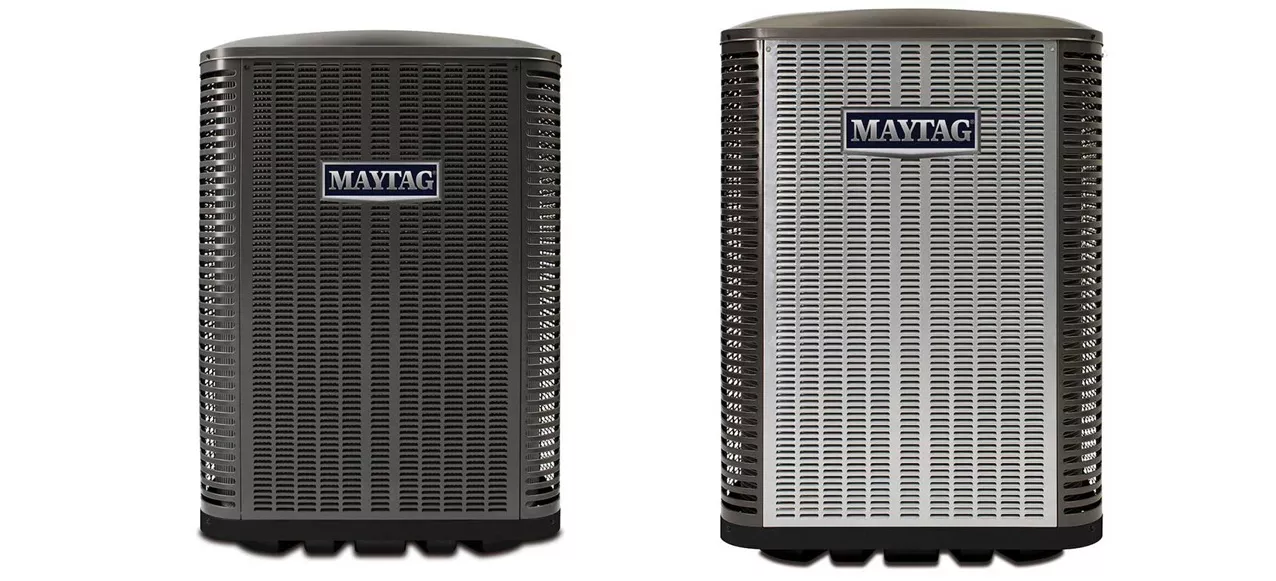
✅ Verdict: Carrier delivers tighter humidity control at very low load; Maytag stays convincingly comfortable on long first-stage cycles when airflow and charge are on spec.
Heating Performance
🟦 Carrier: The Infinity 98 modulating furnace trims fuel in small steps with a variable-speed ECM blower (electronically commutated motor that adjusts speed precisely), so supply air rises smoothly on long winter runs instead of surging and coasting. The Infinity 24 heat pump uses an inverter to hold low-speed heat longer, and defrost cycles are coordinated with blower ramps to avoid cool-air drafts. In dual-fuel setups the control pivots between electric and gas based on a configurable balance point (the outdoor temperature where gas becomes cheaper or more comfortable than electric), which keeps bills and feel predictable as weather swings.
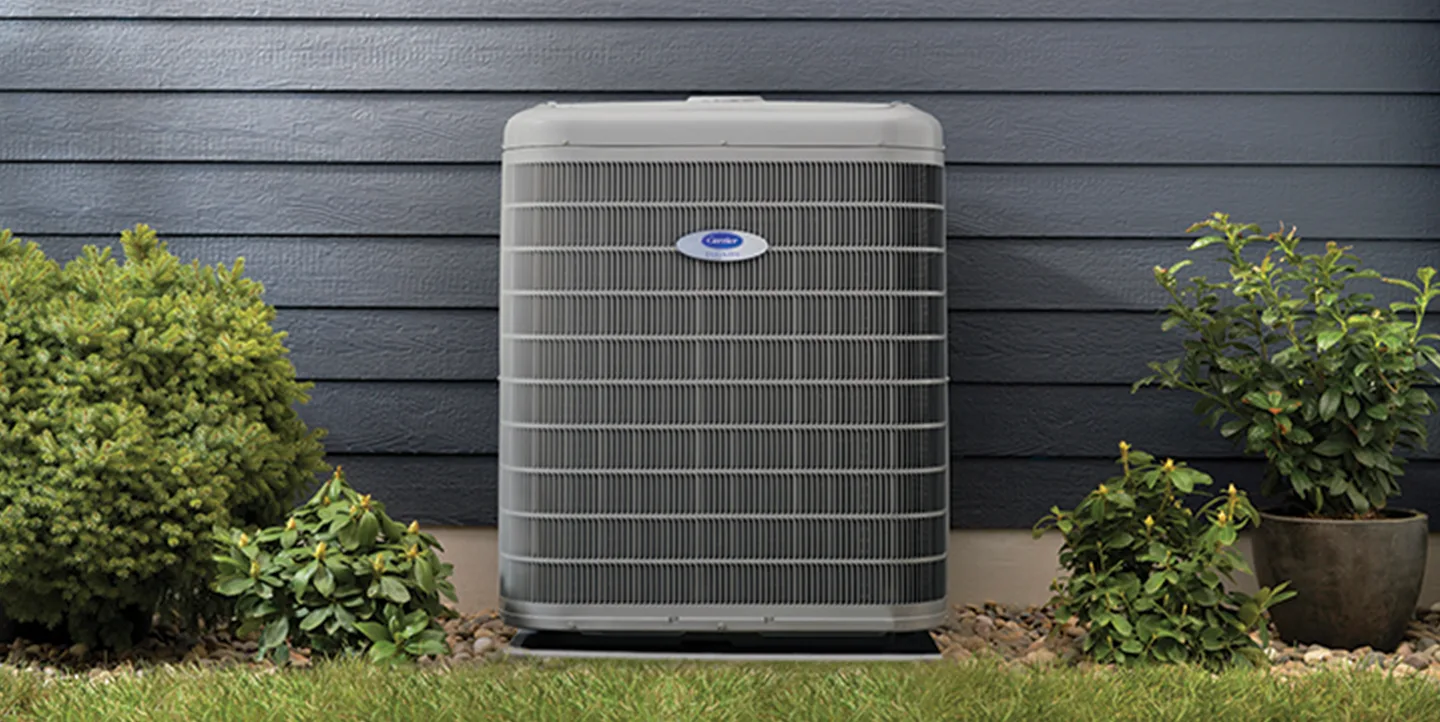
🟪 Maytag: The PGC2TE-VS two-stage furnace spends most hours on low fire with gentle ECM ramps, which already covers a lot of comfort without the complexity of full modulation. The PSH4BE two-stage heat pump favors long low-stage cycles in shoulder seasons, and demand-defrost helps minimize comfort dips after a clear. You do not get the micro-steps of a modulating burner or inverter compressor, but with correct sizing and airflow the room-to-room steadiness is still strong.
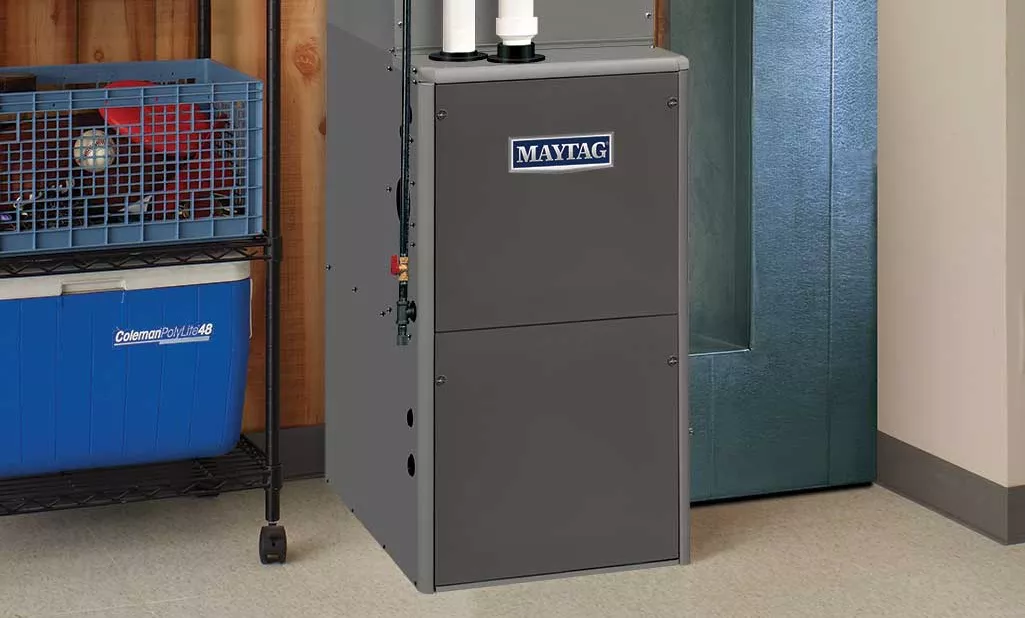
✅ Verdict: Carrier delivers finer temperature control and a very seamless dual-fuel handoff. Maytag is reliably even on low stage, though it cannot match the ultra-fine granularity of Carrier’s variable gear.
Indoor Air-Quality Enhancements
🟦 Carrier: IAQ is treated as part of the system rather than add-ons. High-MERV media cabinets slot in cleanly (MERV rates how small a particle a filter can capture), whole-home humidifiers and dehumidifiers coordinate with blower speed, and balanced ventilation adds ERV/HRV where needed (ERV/HRV bring in outdoor air while exchanging heat or moisture). During muggy spells the control trims cfm per ton (airflow per ton of cooling) so the coil runs slightly colder for stronger latent removal, which holds indoor RH near the mid-40s to 50 percent band without overcooling rooms.

🟪 Maytag: The platform supports deep media filtration, UV or electronic air cleaners, and standard humidifier kits with straightforward thermostat control. Because staging is simple, airflow targets are easy to keep in range, which protects external static pressure in the ducts (external static pressure is airflow resistance, measured in inches of water column) and preserves quiet at low speed. Add an ERV/HRV and you have a complete, serviceable IAQ plan that does not require a steep learning curve.

✅ Verdict: Carrier’s one-umbrella choreography of filtration, humidity, and ventilation is a notch tighter. Maytag keeps IAQ effective and simple, favoring clarity and maintainability over bells and whistles.
Installation & Serviceability
🟦 Carrier: Premium outcomes start with Manual J load, Manual S selection, and Manual D duct design, then move to verification in the field. Commissioning targets include 350 to 400 cfm per ton, total external static at or below ratings, a nitrogen pressure test, deep evacuation, and charge confirmation by superheat and subcool readings (superheat and subcool verify the refrigerant is boiling and condensing in the right places). The Infinity System Control logs events and exposes coil, compressor, and blower data so techs can confirm coil delta-T quickly (delta-T is the return-to-supply temperature drop).
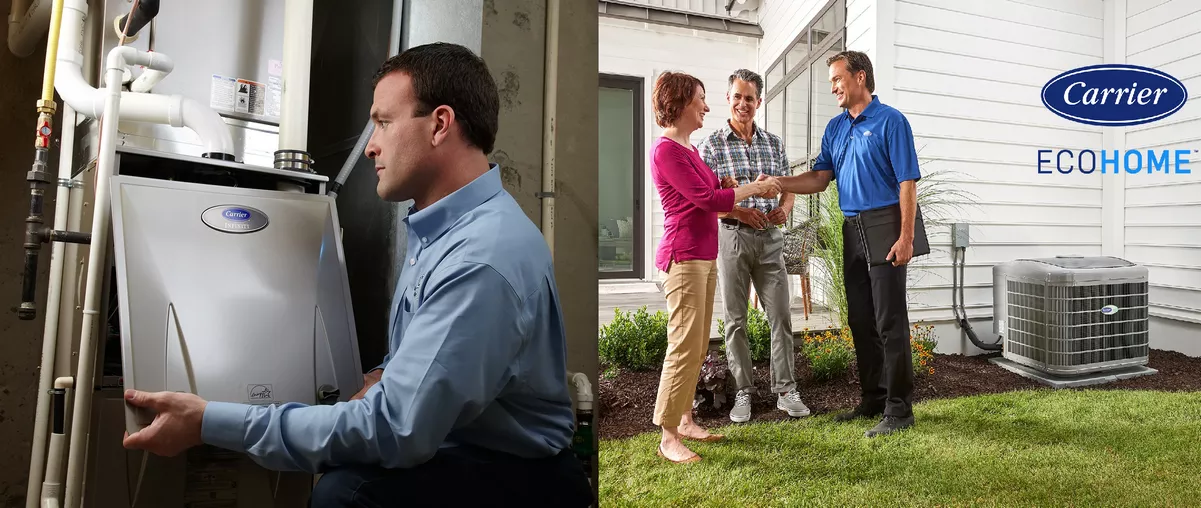
🟪 Maytag: Two-stage equipment with ECM airflow is quick to commission when ducts are reasonable. Match the approved coil, verify airflow, weigh in charge, and the staging profiles do the heavy lifting without a maze of settings. Service access is direct, shared components across sister brands help with parts availability, and the absence of deep modulation can make post-repair verification faster in busy season.
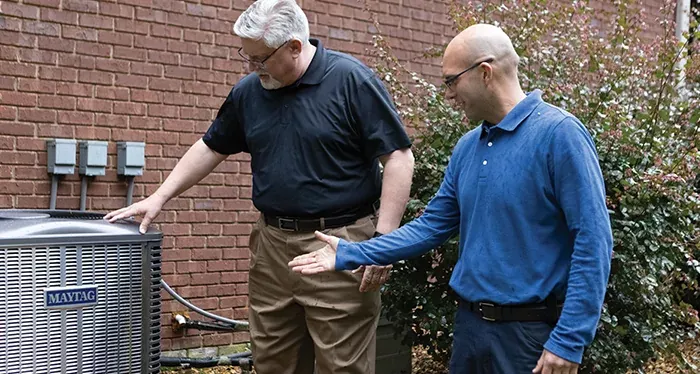
✅ Verdict: Carrier gives technicians rich diagnostics and a mature playbook that speeds peak-season fixes. Maytag is installer-friendly and forgiving, rewarding clean fundamentals with minimal fuss.
Quick Buyer Match Guide
🟦🟦 Choose Carrier if you
You want true variable-capacity comfort with polished dual-fuel behavior, tight humidity control under one smart control, and diagnostics that make midsummer service quick and surgical.
🟪🟪 Choose Maytag if you
You prefer straightforward two-stage hardware that is easy to live with, want quotes that typically land lower than full variable-speed builds, and value simple IAQ add-ons that just work.
Conclusion
Rheem prioritizes clarity, cohesive IAQ control, and modulating gas-heat finesse that feels exceptionally even in winter. Trane emphasizes granular match-ups, ultra-steady low-speed behavior from the XV line, and a field reputation for fast, predictable support. If you want the cleanest upgrade path and tight IAQ orchestration, pick Rheem. If you want dial-it-in flexibility and the safest bet on service consistency, pick Trane.

